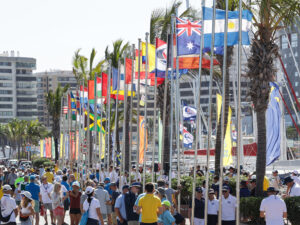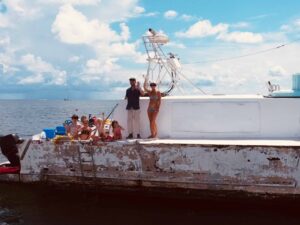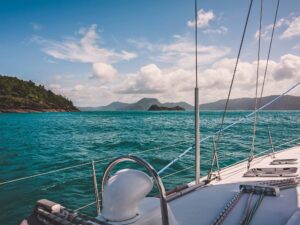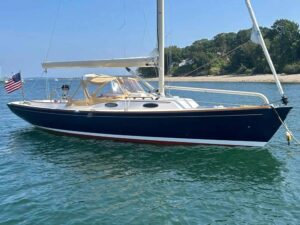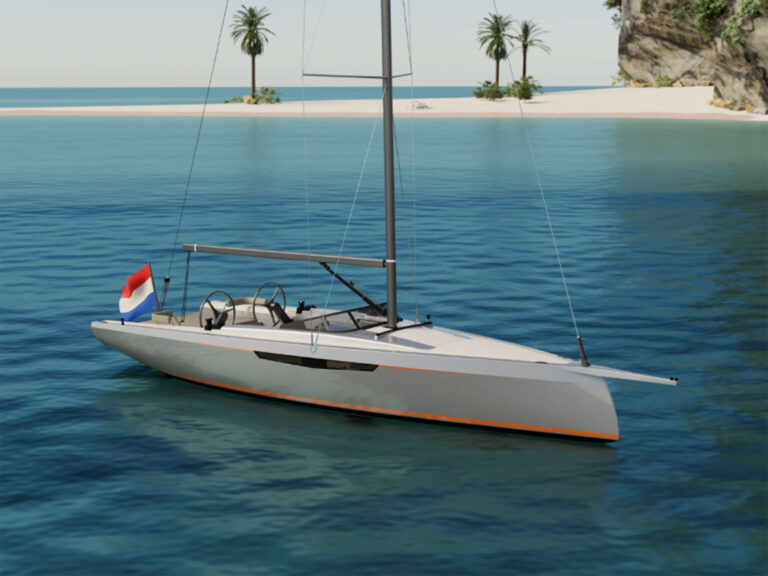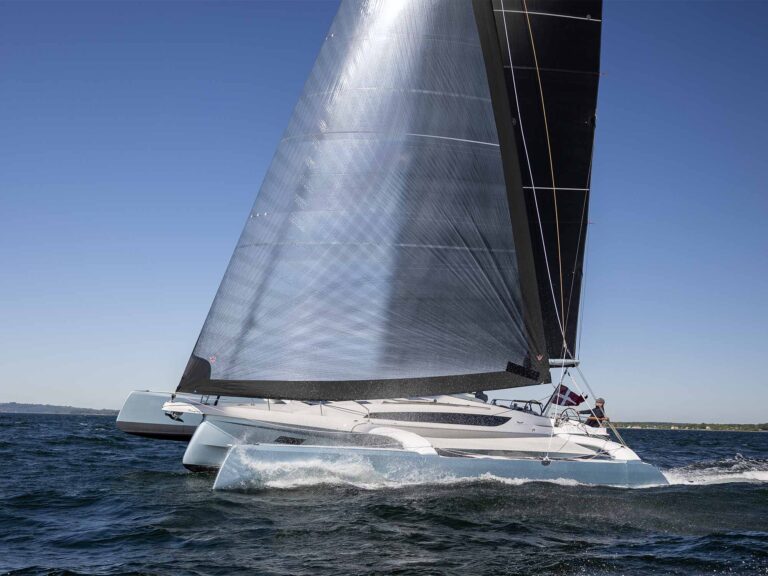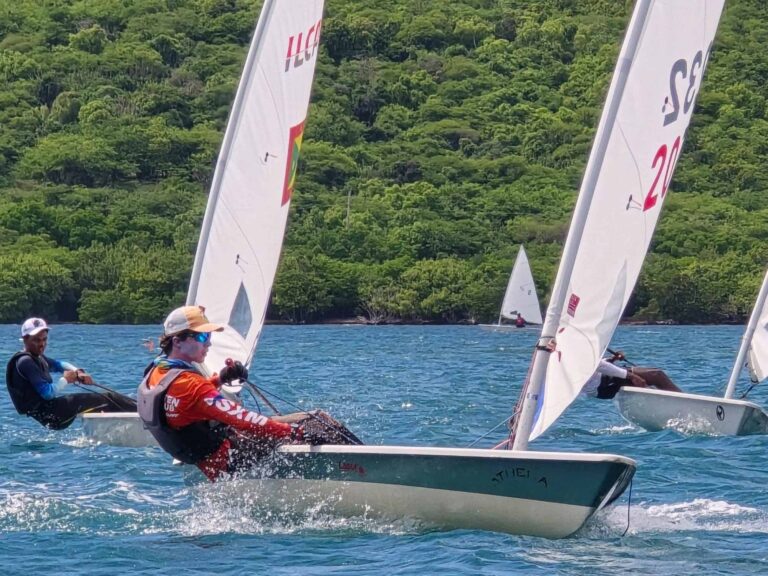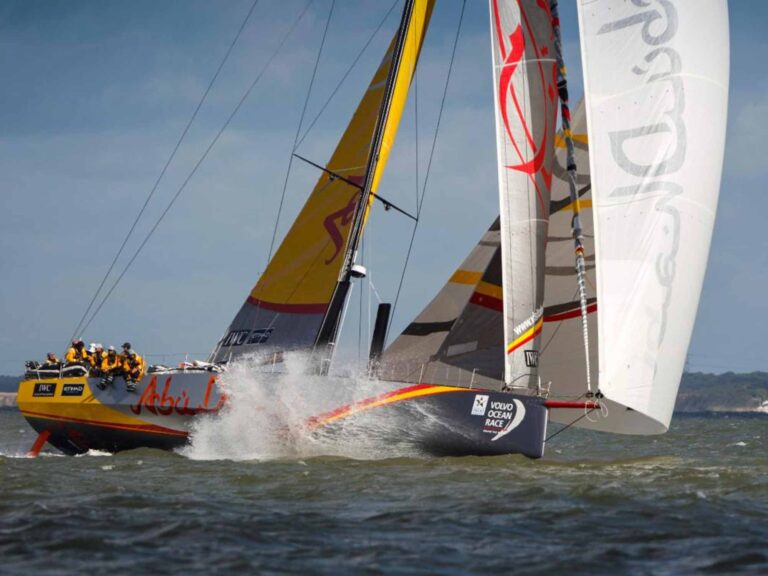Something was in the air in 1974, a filling breeze that brought new ideas and a trio of yacht designers to forever change the world of cruising under sail.
In Newport, Rhode Island, it was an America’s Cup summer. Courageous’ summer. I was there, skippering the Alan Gurney-designed, 47-foot Kittiwake, looking for charters, sneaking out to the racecourse between coats of varnish, and forming a bond with the town that would ultimately draw me back.
In a small house on a Newport back street, Murray Davis was assembling a publication that would give expression to sailors who’d chosen the cruising life.
In another small house not far away, Yves-Marie Tanton was finding out what it was like to be a self-employed yacht designer, with just his name in the title block of the drawings he sent out, not that of a company with a worldwide reputation.
Tanton had landed in New York on a wintry March afternoon in 1971 with $100 in his pocket and an interview appointment at the design office of Sparkman & Stephens. Already something of a prodigy in his native France–he’d spent some of his National Service at the test tank at the engineering college in Nantes (the École Nationale Supérieure de Mechanique) researching 12-Meter designs for Baron Bich’s America’s Cup effort–Tanton expected his next career step would be in this prestigious office. But something in the starched-collar atmosphere put him off, and he instead boarded a train to Boston. Three days later, he was in a converted World War II submarine-spotting tower on the coast at Nahant, Massachusetts, working at Carter Offshore. Among the tyro designers who would man the boards at his side in this dynamic office were two others whose futures would be closely bound with that of Cruising World and its readership: Chuck Paine and Bob Perry.
Dick Carter was an impassioned sailor blessed with a vision and wealthy antecedents. When the new International Offshore Rule (IOR) was launched in 1968, his office was flat out, creating boats for racing sailors eager to play the newly defined game. While his staff, led by Tanton, pushed out drawings, Carter flew around the world signing clients and organizing production runs of boats to be built in Poland, Greece, and Japan. The designs flew off the boards–the Carter 37, the Carter 39, Half-Tonners, One-Tonners (Ydra won the One-Ton Cup in 1973), Vendredi Treize (Jean-Yves Terlain’s monster 128-foot entry in the 1972 OSTAR)–until the spike in polyester-resin prices caused by the Arab oil embargo of 1973 made the bankers carrying Carter’s lines of credit blink. They cut him off. Carter Offshore drifted to a standstill.
Tanton and his colleagues, Bob Perry and Chuck Paine, had little choice but to make their own separate ways in the unpredictable world of yacht design.
Yves-Marie Tanton
Tanton moved to Newport, where in 1974 he set up his own design studio. He also opened a yacht brokerage to generate cash for his embryonic business, taking on two young men, Joe Smith and Billy Rudkin, both well connected in the yacht-racing scene, to hustle clients. They did such a good job that they quickly sold all the boats on the list, and Tanton, feeling responsible for their lack of income, let them go.
“It was probably the worst business decision of my life,” he says. “What I didn’t realize at the time was that they didn’t care about the income. They were from rich families, and quite happy just to be in Newport with all its boats, bars, and girls.” To this day, he feels that if he’d hung on to the brokerage, it would have become established well enough to carry the design business through lean times.
Smith and Rudkin went on to solid careers with respectable brokerage houses, while Tanton, whose expertise with the lumps and bumps of the IOR drew a wave of clients, set up a shop wherein to build his designs. To take advantage of the Small Business Administration’s incentive program, he took on a partner, George Brandariz. “I needed George to get the SBA loan for the business. He was from Argentina and therefore a Spanish-speaking minority, which was a big help. There were no special favors for a French-speaking minority like myself. We were too minor a minority.”
In 1976, Branton Yachts opened its doors on East Main Road, Portsmouth, Rhode Island, and began building Tanton-designed IOR boats in the current medium of fashion–the Gougeon Brothers’ WEST System of wood and epoxy. An ad in the local paper brought me to Branton Yachts–I was now ashore and writing occasional articles for Cruising World–and George hired me. The first boat we built was Black Gold, a Two-Tonner.
The last Tanton boat built on East Main Road was Circus Maximus, Tanton’s take on the IOR sled concept that was launched about six months after Bill Lee’s Merlin was on the U.S. West Coast. After that, Tanton, for whom boatbuilding wasn’t paying an adequate return on the tribulations incurred, handed his keys to Brandariz. Circus, truly a boat ahead of both her time and the technology used in her construction, proved fodder for the skeptics early in her career, but finally set her record straight by taking line honors in the 1978 Newport-Bermuda Race. She also set a Marblehead-to-Halifax Race record that stood for 10 years.
For a few years, Tanton was clearly in the vanguard of IOR designers, and although he produced several winning designs–Desperado, Special Edition, Scaramouche–and his Love Machine was the subject of a spectacular photo series taken in the Miami-Nassau Race in 1975, he says no sailing-magazine writers or editors ever asked to interview him.
Well, the IOR faded into oblivion, racing clients went to the new generation of computer-savvy designers, and Tanton had to look elsewhere for his supper. But no matter how lean the times, he continued drawing, drawing, drawing, always searching for better solutions to the problems that boatbuilders have always faced. Among the beneficiaries of his scribblings and scratchings are numerous French civil servants who’ve occupied long off-duty hours in their postings in French overseas departments welding together and fitting out sailing escape pods to one or another of Tanton’s steel, constant-angle hull designs.
“My boats get built one at a time, but they’ve been built in 40 different countries,” Tanton says, “and right now I’m working on India.”
While he didn’t have much luck selling himself to production builders, the designs he did get series built were generally off mainstream. His most prominent entry in that genre was the cat-ketch-rigged Tanton 43, which was fitted with carbon-fiber spars that were filament-wound on a machine used to make missile nose cones for the Department of Defense–and this in 1979.
Another of his designs, the 68-foot cat schooner Magie Noire, has been quietly crossing the Atlantic season after charter season for a score of years. She’s a little tired looking now, Tanton says, and seeking a new owner, but her plywood-and-fiberglass wing masts are still standing.
Today, Tanton works out of his office above the Newport Post Office with its view over the harbor, occasionally picking up his binoculars to gaze at a passing 12-Meter, “The best daysailer ever created.” He’s had to branch out in recent years, and he’s been working on T-boats–passenger vessels–the precursor of which passes across his view several times a day: the unromantically named Sightsailer, chine built in aluminum and designed for utter simplicity of construction. “There’s only one angle in the hull,” he says, “and the builder, a commercial yard in Louisiana, said it was the fastest it had ever put a hull together.” She’s licensed to carry 16 passengers and has probably taken close to 10,000 people sailing. At $25 per person per 90-minute trip, Tanton reckons she paid her owner back in 52 days. “I guess I’m good for other peoples’ business!”
Chuck Paine
For the same reason that Tanton doesn’t expect ever again to design sailboats for series production, Chuck Paine began years ago to diversify his portfolio.
Since the late 1960s, American boatbuilders have never been particularly generous in assigning designs to freelancers, and all of the remaining major players–Island Packet, Hunter, Catalina, Tartan/C&C, J/Boats–have in-house teams design their boats.
Although Paine had known from a young age he wanted to design yachts, he graduated from Brown University with a degree in mechanical engineering. This has worked in his favor.
“My staff today is made up of engineers,” he says, pointing out the greatest change that’s driven the discipline in generations. “The yacht-design business today is essentially all about engineering.”
Yacht design has always been a blend of art and science, but the structural requirements had for centuries been fulfilled by drawing on “prior art.” Lloyd’s, the pre-eminent shipping authority, had drawn up scantling rules to be met if ships were to be insured, and Nathaniel Herreshoff, of Bristol, Rhode Island, and the Nevins yard, of City Island, New York, among others, had drawn up their own scantling rules for the construction of wooden yachts. Other designers and builders found it practical to work with these systems until the arrival on the scene of reinforced composites threw them to the wind, and designers had to start thinking of their boats no longer as planks and frames but as monocoque structures.
When Chuck Paine left Carter Offshore, in the spring of 1974, he hung up his shingle in Maine, because, apart from being cheap, it was a wonderful place for someone so impassioned about boats to be. Of course, a shingle, in itself, doesn’t guarantee any business, so one of his early moves was to go cap-in-hand to Murray Davis, figuring that if he couldn’t just yet make a living designing boats, he could at least earn a crust writing about design for Cruising World. His well-crafted series of articles, which appeared between August and November 1977, shed a bright light not just on the reasoning that goes into designing sailing craft but also on his own approach to the process. They make good reading today. Back then, they put Chuck Paine’s name in front of a key audience.
Paine started down his solo path building a boat to his design. “I sold my first boat to an insurance company,” he says. “The shop I built it in burned to the ground, the near-complete boat with it. Fortunately, that was in the days when insurance companies paid out.” Fortunately, too, Tom Morris had seen the boat and liked it so much he put the 26-foot Frances into series production, ultimately building 40 of them. And Frances so impressed Bernard Hayman, editor of Britain’s Yachting World, that he held her up as an example for British boatbuilders, whom he described as inept, to emulate. The consequences included a license arrangement between Morris Yachts and England’s Victoria Yachts, which became a long-term business association, and subsequent design commissions for Paine from Bowman Yachts and from private clients in Europe.
Paine became the long-standing designer of record for Morris, and through the relationship, he’s expanded his talents to the design of racing yachts with full cruising interiors, of which Reindeer and Firefly (whose hulls were built for Morris by another Carter alumnus, the exotic-composite specialist Mark Lindsay) have been the most visible examples.
It’s fair to say that his association with a high-quality builder like Morris helped Paine to garner the custom-design business that has been his mainstay and supports his five-strong office today. But Paine has also been astute in staying on the leading edge of cruising-boat development. From the shapely but staid Frances, which was assured a warm reception among the old school of yachtsmen, he’s progressed through his Bermuda series, built by Able Marine, to his current benchmark long-waterline, light cruisers outfitted with every high-tech sailing aid in the catalog. His portfolio, “a brief sample of our more recent work,” he calls it, contains three pounds of what constitutes eye candy for boat lovers.
However, the tepid stock market and national jitters post September 11, 2001, Paine says, have caused his clientele to be more cautious with their money. “They’re buying waterfront property, in the form of motor-yachts or real estate in Florida. I’m not so worried for myself, as I’ve done well and can spend more time sailing my Herreshoff Twelve and a Half. But for the sake of the team, I’ve had to look more and more at the powerboat side. We’ve lately been designing five motor-yachts for every sailboat.”
I heard a similar tale from Tanton, who’s backed up his sailing catalog with a line of lobster yachts based both on his hull designs and those of the masters of the type in Maine.
Robert H. Perry
Far away on the West Coast, Robert H. Perry is also finding sustenance on the “dark side” by designing the occasional motorboat.
“Every time I threatened to leave Carter Offshore,” Perry says, “Dick raised my salary. But though we were the highest-paid designers at the time, it was still well short of the money I’d earned through college playing in a band.” Then came a day in 1974 when Perry made his threat, his colleagues made their customary bets on how much his raise would be, and Carter simply said, “I wish you the best of luck.”
He immediately moved back to Seattle. “It was obvious that Carter’s business was slowing down,” he says. “Clients were going to Ron Holland and Doug Peterson, and I had work outside.” That work was the Valiant 40, and its line drawings appeared in the inaugural issue of Cruising World, and although he’d rather be thought of for some of his more recent designs, Perry admits that the Valiant 40 represents a significant milepost in both his career and the subsequent development of cruising-boat designs. It proved to a skeptical American sailing public–Europeans had already learned this from Van de Stadt–that separating the rudder from the keel doesn’t automatically consign a sailboat to the racecourse or to Davy Jones.
Perry still ponders the events that led to his becoming the darling of the production cruising-boat industry, when his first love had been racing. However, boats built to his designs began appearing in great numbers and from a variety of builders: CT, Tayana, Islander, Passport, LaFitte. He was particularly successful with builders in the Far East, and he established close relationships with many of them, not least because he took pleasure in learning Mandarin Chinese to communicate better with them and to engage with the culture. Anyone interested in the ins and outs of Taiwanese boatbuilding in the 1980s should read Perry’s essay in Dan Spurr’s history of fiberglass boatbuilding, Heart of Glass.
At the best of times, however, designing yachts is a precarious way to make a living, and like his colleagues from Carter, Perry needed a little stability when he was getting started. He found it at Evergreen State College, where he taught yacht design as part of a Maritime History and Crafts curriculum–a “part-time job with a full-time paycheck,” as he describes it. He also landed a monthly column in Sailing magazine in which for 22 years he has critiqued the designs of his peers, no doubt benefiting immensely from the process. He remembers his former office mates, though. “Perry printed every design that I submitted,” Tanton once told me.
“I only review designs I think are good,” says Perry, “and he sends me good designs.”
Perry also acknowledges the designers who have influenced him the most, and as well as listing Bill Garden, Phil Rhodes, and Bill Tripp Sr., he looks back fondly on the close association he had at Carter with Chuck Paine and Yves-Marie Tanton.
As the industry has changed, Perry has had to adapt. He too felt the squeeze when his production-boat clients one by one closed up shop and the domestic builders kept their doors closed to outside designers. Most of his efforts in recent years have been directed toward one-off performance cruising boats and even racing sleds.
However, opportunities still arise in the production arena. Perry has recently designed a 53-footer that will be produced in mainland China. It’s for Bill Stevens, the founder of Stevens Yachts, an early bareboat-charter company (later bought by Sunsail), and the instigator of the Morgan OI 41 and the Stevens 47. It so happens that Bill Stevens put me on Kittiwake and sent me to Newport in 1974 so I could fall in love with the town, make it my first choice of home when I stepped ashore, and go cap-in-hand to Murray Davis with my own writing samples.
Jeremy McGeary never expected to be a CW associate editor, but Newport’s summer sea breeze has a way of affecting the courses of those who sail into it.

